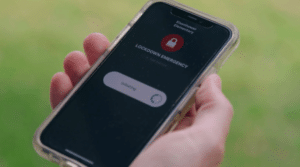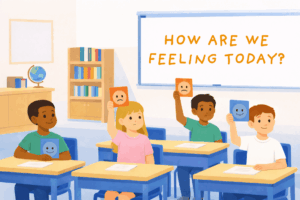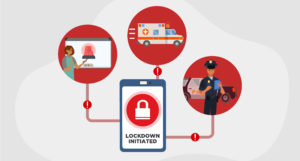What is a swatting hoax?
Swatting is a term coined by the FBI for a specific type of false report, made with the intention of drawing a massive law enforcement response to a particular location. These reports typically allege active shooters, mass casualties, or other violence.
This has become a widespread issue throughout the United States. According to the K-12 School Shooting Database, there were over 850 swatting incidents targeting schools in a single 18-month period from 2023-2024.
While swatting hoaxes don’t involve actual threats, their impact on school safety is very real. Schools must enact their lockdown protocols and local law enforcement responds as if each incident is credible. In some cases, concerned parents have arrived on-scene, wanting to verify that the threats are false.
Anonymous reports or writings on bathroom walls by students, specifying a date and time that an alleged incident will occur, are common ways to trigger a swatting hoax. The objective behind these types of hoaxes is often seemingly innocent—like canceling or delaying a scheduled exam.
According to Hutto (TX) Chief of Police Jeff Yarbrough, “Years ago in schools, you would have people making these bomb threats during the time when you have tests so they can avoid going and taking the tests. And what we’re seeing now is just a progression of that same behavior to trigger law enforcement response to have an outcome that the caller or callers seek to engage.”
How swatting hoaxes impact schools
False alarms, including those caused by swatting, have the potential for a range of negative impacts. These can include:
- Safety concerns for law enforcement officers, first responders, and school and community members in the vicinity during the heightened state of alert as the scene is secured and responders arrive ready to find a dangerous situation.
- Emotional consequences for staff, students, and parents/guardians who, even for a brief time, experience the emotions of being in a real, life-threatening situation. Even in the event of a fake shooter, the mental health impacts should be taken seriously. The National Institute of Mental Health recommends limiting exposure to news coverage about the situation, maintaining normal routines, and contacting a health care provider if any new issues occur.
- Potential lax response to future security alerts, creating a “cried wolf” situation and diminishing the response time of those involved should a real emergency arise in the future.
- Cost to taxpayers, as each incident requires the same full attention and response that a real threat of violence requires, using valuable financial and human resources during response and in the post-event investigation.
- Pre-attack surveillance can provide potentially dangerous insight into any security gaps that could be leveraged for a real attack.
Mitigating the impact of swatting in schools
Fake threats can cause trauma and emotional distress in students, faculty and parents. We’ve covered some strategies to prevent swatting in this article, but even with a proactive approach, schools can still experience a swatting incident.
Here are a few ways to lessen the impact of fake school threats on students and staff:
- Enable two-way communication capabilities. This gives administrators the ability to communicate with staff quickly and discreetly during an incident. Administrators can update staff quickly and reduce the amount of time they and their students believe an active shooter incident is imminent.
- Engage those impacted by fake threats in a conversation to talk through what thoughts, feelings, and emotions they experienced. Doing so provides an opportunity to validate feelings and concerns. Continuing an open dialogue for the days, weeks, and months following potentially traumatic events lets students know they have a safe place to process their thoughts about the experience.
- Educate students about swatting. Letting them know what to do if they hear about a potential threat and how to keep themselves safe in the event of a lockdown empowers students to help combat insecurities these fake threats may bring up.
- Teach students about the potential harm of swatting—particularly the trauma and increased risk it poses to their peers. This could reduce the chances of a student executing a false threat themself.
It is also critical that staff members know how to recognize the signs of a student who is struggling. Engaging in behavior like hoax calls could be a symptom of something more serious.
This graphic illustrates some of the behaviors and cues to watch for in students, across age groups:

Though subtle, these low-level concerns can provide counseling staff with the insight they need to support students sooner. Learning to recognize these signs should be part of staff safety training and compliance.
Document Low-level Concerns with Raptor StudentSafe
Schools need the right set of tools to help document and recognize patterns of concerning behavior to best support students.
Staff observations of patterns indicating a student needs guidance are often recorded in multiple locations like email, written notes, and hallway conversations—but this means leaving gaps that some students may slip through without receiving care.
Instead, it’s important to centralize all these concerns so counselors can have a clear, coherent chronology of a student’s experience. Counselors could intervene much sooner, leveraging their expertise when problems are still manageable.
In more serious situations that require violence prevention, having the whole picture is even more important. It allows counselors to escalate a concern into an assessment of potential harm to self or others, offering all the relevant information within the same system.
Raptor StudentSafe™ is the sole K-12 software that captures student wellbeing policies in a secure platform. It enables logging minor concerns and seamless escalation to formal protocols, fostering staff collaboration and enhancing student support.
“The Raptor app is the fastest and easiest way to communicate and avoid as many problems or damage as possible in the event of an emergency.” – Dalia Tammo, Emergency Management User at Glendale Unified School District in California.
Providing all staff—janitors, bus drivers, and office staff as well as teachers and school administrators—with the means to share concerns about a student with the school counselor creates a network of observers. With documented concerns only viewable by approved staff, this empowers your school counselors with a deeper, more holistic understanding of student needs.
Learn practical next steps and insights to improve your school’s student wellbeing practices in the webinar Turning Policy Into Action.
Related Resources
Guide to K-12 Emergency Management
Proven Strategies to Protect Your School
